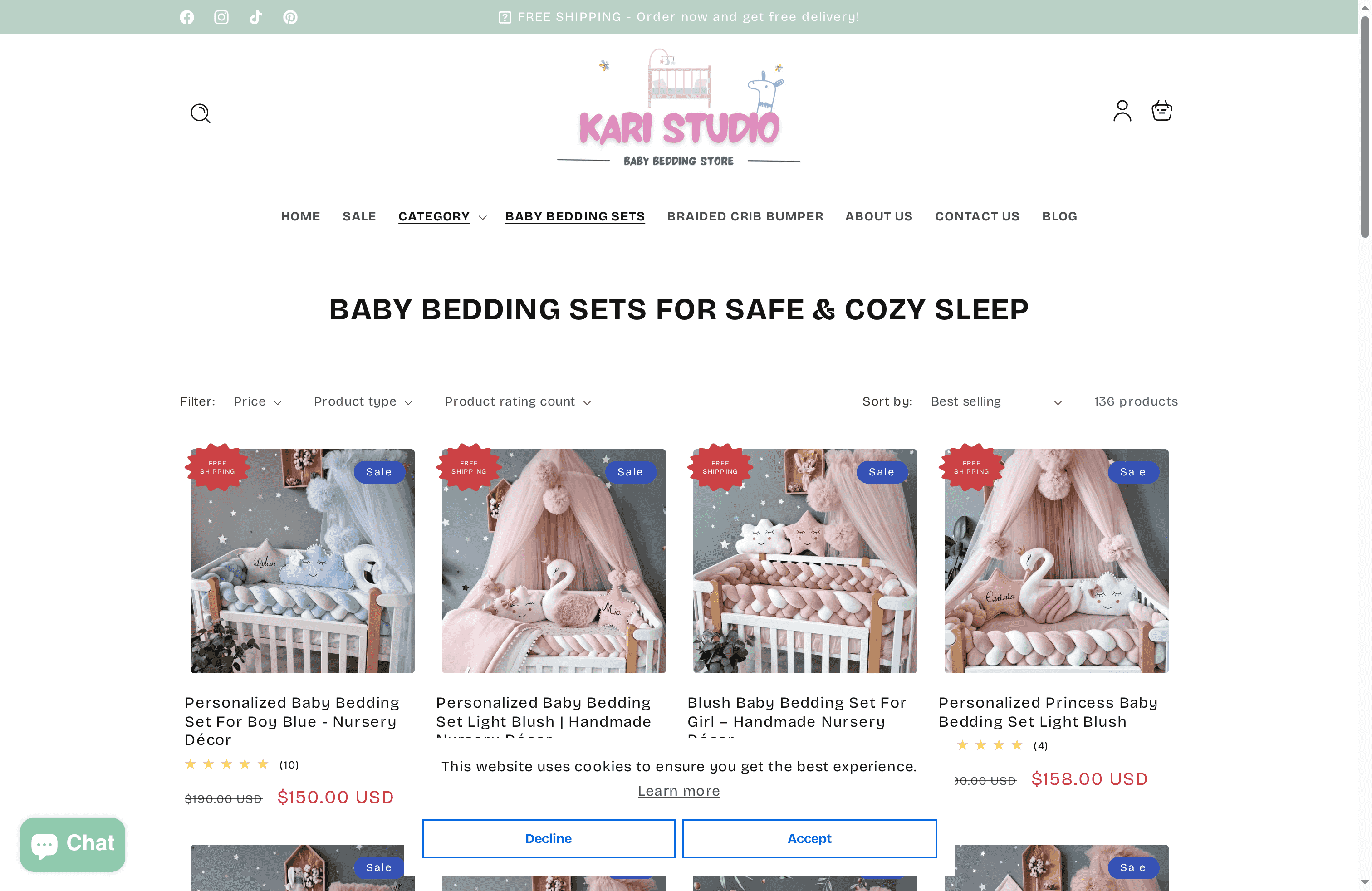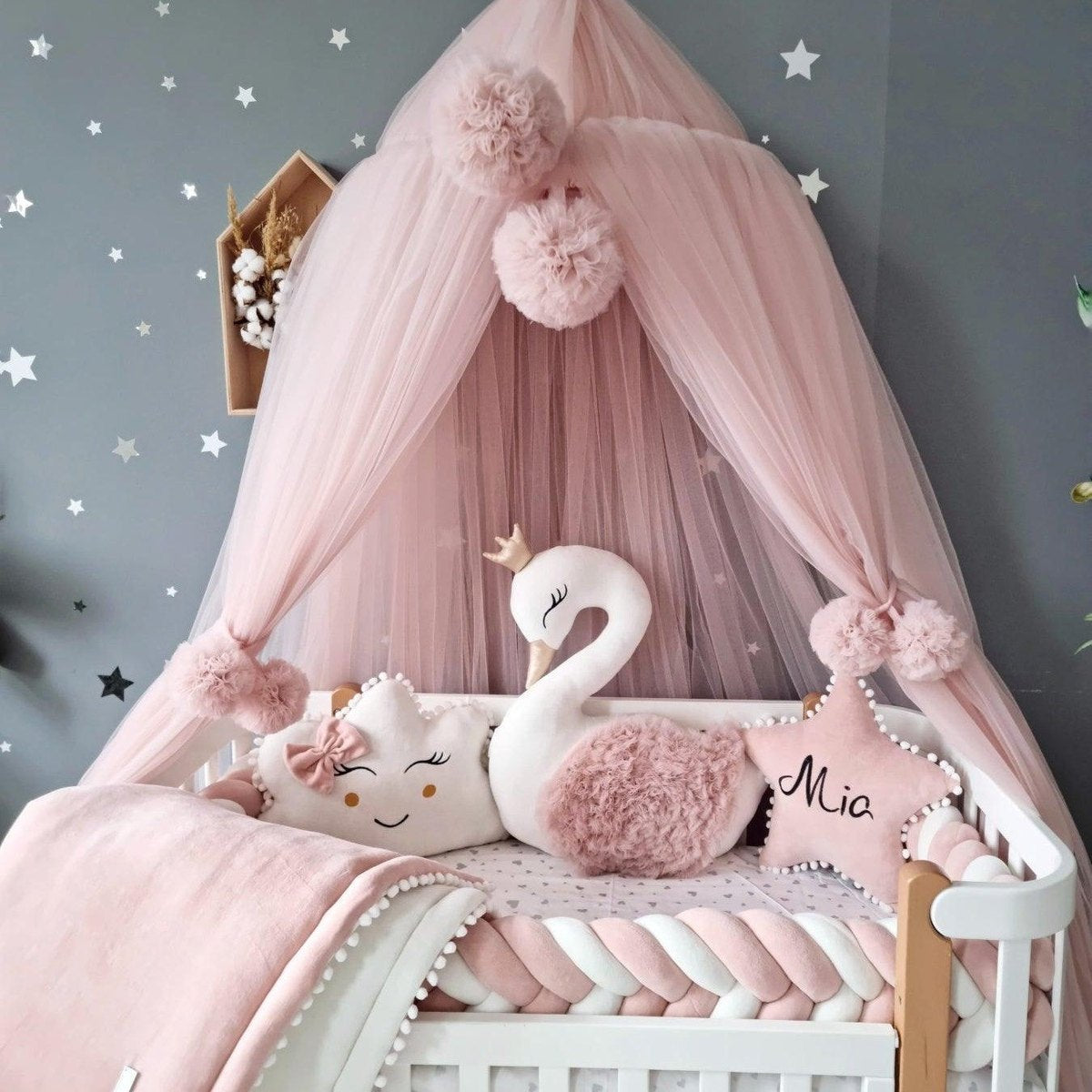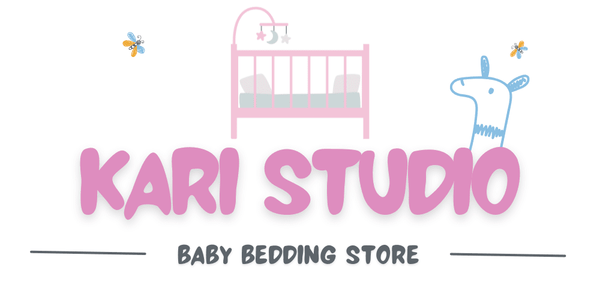Über 80 Prozent der Neugeborenen schlafen innerhalb von nur fünf Minuten nach dem Hören von weißem Rauschen ein – eine Statistik, die viele amerikanische Eltern, die sich einen besseren Schlaf für ihre Babys wünschen, aufhorchen lässt. Angesichts der unvorhersehbaren Geräusche im Haushalt und des Stadtlebens ist es in einem amerikanischen Zuhause keine leichte Aufgabe, für einen ruhigen Schlaf zu sorgen. Zu verstehen, wie weißes Rauschen wirkt und welche Arten es gibt, kann Eltern helfen, eine beruhigende und sichere Atmosphäre zu schaffen, die einen gesunden Babyschlaf fördert.
Inhaltsverzeichnis
- Was ist weißes Rauschen für Säuglinge?
- Arten von weißem Rauschen und ihre Unterschiede
- Wie weißes Rauschen den Babyschlaf unterstützt
- Sicherheitshinweise zu weißem Rauschen: Lautstärke und Platzierung
- Häufig gestellte Fragen zu weißem Rauschen für Babys
- Besser schlafen mit den Baby-Basics von Kari Studio
Wichtigste Erkenntnisse
| Punkt | Details |
|---|---|
| Weißes Rauschen verstehen | Weißes Rauschen schafft eine beruhigende Umgebung für Säuglinge, indem es störende Geräusche ausblendet und vorgeburtliche Erfahrungen nachahmt. |
| Arten von weißem Rauschen | Zu den Optionen gehören elektronische Geräte, natürliche Klanggeneratoren und Smartphone-Apps, die jeweils einzigartige Klangprofile bieten. |
| Sicherheitsrichtlinien | Um das Gehör zu schützen, sollte die Lautstärke moderat eingestellt und die Audiogeräte mindestens 2,1 Meter vom Kinderbett entfernt positioniert werden. |
| Überlegungen der Eltern | Beobachten Sie die Reaktionen des Babys auf weißes Rauschen, um eine Abhängigkeit zu vermeiden, und beurteilen Sie gleichzeitig dessen Wirksamkeit bei der Förderung des Schlafs. |
Was ist weißes Rauschen für Säuglinge?
Weißes Rauschen ist ein gleichmäßiges, konstantes Geräusch, das störende Umgebungsgeräusche überdeckt und eine beruhigende Atmosphäre für den Babyschlaf schafft. Laut Healthline bezeichnet weißes Rauschen Geräusche, die Haushalts- und Hintergrundgeräusche effektiv ausblenden und so eine ruhige, erholsame Umgebung schaffen.
Das Konzept des weißen Rauschens ist von der vorgeburtlichen Erfahrung eines Babys inspiriert. Die Regierung von Manitoba erklärt, dass Säuglinge im Mutterleib an gleichmäßige, rhythmische Geräusche wie den Herzschlag der Mutter gewöhnt sind. Dies erklärt, warum sich wiederholende, gleichmäßige Geräusche nach der Geburt für Neugeborene äußerst beruhigend auswirken können.
Hauptmerkmale von weißem Rauschen:
- Gleichbleibende Schallfrequenz
- Einheitliches Audiomuster
- Blockiert plötzliche Umgebungsgeräusche
- Simuliert die Geräuschumgebung im Mutterleib
Weißes Rauschen erzeugt ein sanftes, gleichmäßiges Klangspektrum, das andere potenzielle Störgeräusche quasi „neutralisiert“. Man kann es sich wie eine akustische Decke vorstellen, die abrupte Geräusche dämpft und so eine vorhersehbare akustische Umgebung schafft, in der sich Babys sicher und entspannt fühlen. Ob durch spezielle Geräte, Smartphone-Apps oder natürliche Quellen wie Ventilatoren oder Regen erzeugt – weißes Rauschen ist eine wissenschaftlich fundierte Methode, um den Schlafrhythmus von Säuglingen zu unterstützen.
Für Eltern, die eine optimale Schlafumgebung suchen, kann die Kombination von weißem Rauschen mit Verdunkelungsvorhängen im Kinderzimmer eine ideale Ruheumgebung für ihr Kind schaffen.
Arten von weißem Rauschen und ihre Unterschiede
Weißes Rauschen ist keine Einheitslösung. Eltern haben verschiedene Möglichkeiten, beruhigende Hintergrundgeräusche zu erzeugen, die Babys beim Einschlafen helfen. Jede dieser Optionen hat ihre eigenen akustischen Eigenschaften. Wikipedia hebt hervor, dass unterschiedliche Rauscharten, wie beispielsweise rosa Rauschen, verschiedene Klangprofile bieten, die individuell angepasst werden können.
Arten von weißem Rauschen für Babys:
- Elektronische Weißrauschgeneratoren: Gleichmäßige, synthetische Klangerzeugung
- Natürliche Klanggeneratoren: Sie imitieren Umweltgeräusche wie Regen oder Meereswellen.
- Smartphone-Apps: Anpassbare Geräuschoptionen mit Lautstärkeregelung
- Geräuschquellen im Haushalt: Ventilatoren, Luftreiniger oder fließendes Wasser
MyNoise demonstriert die Vielseitigkeit der Geräuscherzeugung durch die Bereitstellung verschiedener Klanglandschaften, die es Nutzern ermöglichen, unterschiedliche Audioelemente zu kombinieren. Dieser Ansatz versetzt Eltern in die Lage, personalisierte akustische Umgebungen zu schaffen, die ihr jeweiliges Baby optimal beruhigen.
Das Verständnis der feinen Unterschiede zwischen verschiedenen Geräuscharten kann Eltern helfen, den effektivsten Klang für ihr Baby auszuwählen.
 Rosa Rauschen klingt beispielsweise eher wie ein sanfter Wasserfall und bietet eine sanftere Alternative zu herkömmlichem weißen Rauschen. Durch Ausprobieren verschiedener Klangprofile können Eltern das beruhigendste Hintergrundgeräusch für den Schlafrhythmus ihres Kindes entdecken.
Rosa Rauschen klingt beispielsweise eher wie ein sanfter Wasserfall und bietet eine sanftere Alternative zu herkömmlichem weißen Rauschen. Durch Ausprobieren verschiedener Klangprofile können Eltern das beruhigendste Hintergrundgeräusch für den Schlafrhythmus ihres Kindes entdecken.
Für alle, die eine umfassende Schlafumgebung anstreben, kann die Kombination von weißem Rauschen mit Verdunkelungsvorhängen im Kinderzimmer eine optimale Ruheumgebung schaffen, die einen tieferen und erholsameren Babyschlaf fördert.
Wie weißes Rauschen den Babyschlaf unterstützt
Weißes Rauschen spielt eine entscheidende Rolle für den Babyschlaf, indem es eine gleichmäßige und beruhigende akustische Umgebung schafft, die an vertraute Erfahrungen im Mutterleib erinnert. Healthline verweist auf eine überzeugende Studie aus dem Jahr 1990, die zeigt, dass beeindruckende 80 % der Neugeborenen innerhalb von fünf Minuten nach dem Hören von weißem Rauschen erfolgreich einschliefen. Dies unterstreicht die bemerkenswerte Wirksamkeit von weißem Rauschen bei der Förderung des Babyschlafs.
Wichtigste Wirkungsmechanismen von weißem Rauschen im Säuglingsschlaf:
- Masken plötzlicher Umgebungsgeräusche
- Verringert Schreckreaktionen
- Erzeugt eine vorhersehbare Klanglandschaft
- Löst eine neurologische Beruhigungsreaktion aus
Die Regierung von Manitoba erklärt, dass sich wiederholende Geräusche wie weißes Rauschen stark beruhigend auf Säuglinge auswirken können, indem sie die rhythmischen Geräusche im Mutterleib genau nachahmen. Diese akustische Vertrautheit hilft Babys beim Übergang von der geschützten intrauterinen Umgebung in die unvorhersehbarere Außenwelt.
Die neurologischen Auswirkungen von weißem Rauschen sind besonders faszinierend. Durch ein gleichmäßiges Klangspektrum erzeugt weißes Rauschen eine Art akustischen Puffer, der verhindert, dass plötzliche akustische Störungen den empfindlichen Schlafrhythmus eines Säuglings beeinträchtigen. Dieses gleichmäßige Geräusch trägt dazu bei, die Stressreaktion des Babys zu regulieren, den Cortisolspiegel zu senken und so einen ruhigeren, ungestörten Schlaf zu fördern.
Eltern, die die Schlafumgebung ihres Säuglings optimieren möchten, sollten sich mit sanften Schlaftrainingstechniken auseinandersetzen, die Strategien mit weißem Rauschen ergänzen und so einen umfassenden Ansatz zur Unterstützung gesunder Schlafmuster beim Säugling schaffen.
Sicherheitshinweise zu weißem Rauschen: Lautstärke und Platzierung
Die Grundlagen für die sichere Verwendung von weißem Rauschen erfordern sorgfältige Beachtung, um das Gehör und das allgemeine Wohlbefinden Ihres Säuglings zu schützen. Healthline berichtet, dass die Amerikanische Akademie für Kinderheilkunde empfiehlt, Geräte für weißes Rauschen mindestens 2 Meter vom Babybett entfernt aufzustellen und die Lautstärke unterhalb der maximalen Einstellung zu halten, um mögliche Gehörschäden zu vermeiden.
Wichtige Sicherheitsrichtlinien:
- Das Gerät zur Erzeugung von weißem Rauschen sollte mindestens 2 Meter vom Kinderbett entfernt aufgestellt werden.
- Die Lautstärke sollte auf einem moderaten Niveau gehalten werden.
- Nutzen Sie die Timer- oder automatische Abschaltfunktion.
- Beobachten Sie die Reaktion des Babys auf Geräusche.
Die Regierung von Manitoba legt Wert darauf, die Lautstärke auf ein Niveau einzustellen, das dem einer sanften Dusche entspricht. Dies beugt Reizüberflutung vor und sorgt gleichzeitig für eine beruhigende akustische Umgebung. So wird sichergestellt, dass das weiße Rauschen eine hilfreiche Einschlafhilfe bleibt und nicht zu einer potenziellen Quelle von Hörstress wird.
Technische Aspekte sind gleichermaßen wichtig.
 Eltern sollten Geräte mit weißem Rauschen wählen, deren Lautstärke einstellbar ist und die idealerweise über einen automatischen Timer verfügen, der die Lautstärke allmählich reduziert. Digitale Geräte mit Dezibelmessung bieten zusätzliche Sicherheit und ermöglichen eine präzise Kontrolle der Geräuschbelastung.
Eltern sollten Geräte mit weißem Rauschen wählen, deren Lautstärke einstellbar ist und die idealerweise über einen automatischen Timer verfügen, der die Lautstärke allmählich reduziert. Digitale Geräte mit Dezibelmessung bieten zusätzliche Sicherheit und ermöglichen eine präzise Kontrolle der Geräuschbelastung.
Für umfassende Strategien zum Babyschlaf sollten Eltern sich mit den Empfehlungen für sicheren Babyschlaf auseinandersetzen, die die Verwendung von weißem Rauschen ergänzen und so einen ganzheitlichen Ansatz zur Schaffung einer sicheren Schlafumgebung gewährleisten.
Häufig gestellte Fragen zu weißem Rauschen für Babys
Weißes Rauschen wirft bei Eltern, die sich über Nutzen und mögliche Risiken informieren möchten, viele Fragen auf . Healthline weist darauf hin, dass weißes Rauschen zwar Säuglingen beim Einschlafen hilft, Eltern jedoch wichtige Aspekte wie mögliche Abhängigkeit und Gehörschutz sorgfältig abwägen sollten.
Die häufigsten Fragen von Eltern zum Thema weißes Rauschen:
- Wann ist der beste Zeitpunkt, um mit der Verwendung von weißem Rauschen zu beginnen?
- Können Babys von weißem Rauschen abhängig werden?
- Wie lange sollte weißes Rauschen jede Nacht angewendet werden?
- Gibt es irgendwelche Risiken im Zusammenhang mit weißem Rauschen?
Die Regierung von Manitoba betont, dass weißes Rauschen ein wirksames Beruhigungsmittel sein kann, seine Anwendung jedoch eine sorgfältige Abwägung von Faktoren wie Lautstärke, Dauer und der individuellen Reaktion des Säuglings erfordert. Eltern sollten weißes Rauschen als unterstützende Maßnahme und nicht als Garantielösung betrachten.
Die häufigsten Bedenken betreffen in der Regel mögliche Hörschäden und die Entwicklung einer Schlafabhängigkeit. Obwohl weißes Rauschen bei korrekter Anwendung im Allgemeinen unbedenklich ist, sollten Eltern die Reaktion ihres Babys beobachten, eine moderate Lautstärke einhalten und gegebenenfalls ihre Vorgehensweise anpassen. Manche Babys können sich an weißes Rauschen zum Einschlafen gewöhnen, daher ist eine schrittweise Reduzierung der Abhängigkeit langfristig eine wichtige Strategie.
Eltern, die umfassende Schlafstrategien entwickeln möchten, könnten zusätzliche Erkenntnisse gewinnen, indem sie sich mit dem Thema Schlaftraining auseinandersetzen, das die Techniken des weißen Rauschens bei der Schaffung gesunder Schlafgewohnheiten für Säuglinge ergänzen kann.
Besser schlafen mit den Baby-Basics von Kari Studio
Für eine optimale Schlafumgebung ist ein ganzheitlicher Ansatz erforderlich, der verschiedene Sinnesreize einbezieht. Healthline bestätigt, dass die Integration von weißem Rauschen in die Kinderzimmerumgebung Haushaltsgeräusche effektiv überdecken und eine gleichmäßige Geräuschkulisse schaffen kann, die die Schlafqualität von Säuglingen verbessert.
Kari Studio Schlafoptimierungs-Essentials:
- Anpassbare Verdunkelungsdächer
- Weiche, atmungsaktive Bettwäsche-Sets
- Hypoallergene Materialien
- Schallabsorbierende Designelemente
Die Regierung von Manitoba empfiehlt, weißes Rauschen mit anderen beruhigenden Techniken wie sanftem Wiegen oder Pucken zu kombinieren, um eine rundum beruhigende Umgebung zu schaffen. Die Babyausstattung von Kari Studio wurde speziell entwickelt, um diese Schlafstrategien zu ergänzen und bietet einen vielschichtigen Ansatz für das Wohlbefinden von Säuglingen.
Die gezielte Integration von Elementen im Kinderzimmer kann die Schlafqualität deutlich verbessern. Die Verdunkelungshimmel von Kari Studio harmonieren perfekt mit Geräten zur Erzeugung von weißem Rauschen und schaffen so eine ruhige, kontrollierte Umgebung, die äußere Störungen minimiert. Die weichen, sorgfältig gefertigten Bettwäschesets bieten zusätzlichen sensorischen Komfort und tragen dazu bei, dass sich Babys geborgen und entspannt fühlen.
Für Eltern, die eine Komplettlösung für den Babyschlaf suchen, können Verdunkelungsvorhänge eine hervorragende Ergänzung zu weißem Rauschen und den umfassenden Babyausstattungsartikeln von Kari Studio sein und so eine optimale Schlafumgebung für ihr Baby gewährleisten.
Schaffen Sie mit Kari Studio den perfekten Schlafplatz für Ihr Baby.
Eine ruhige und entspannende Umgebung ist unerlässlich, wenn Sie weißes Rauschen zur Förderung eines besseren Schlafs einsetzen. Der Artikel beleuchtet häufige Herausforderungen für Eltern, wie das Überdecken plötzlicher Geräusche und das Schaffen einer vorhersehbaren Atmosphäre, die dem Mutterleib ähnelt. Neben Geräuschen spielen Komfort und Sicherheit im Kinderzimmer eine wichtige Rolle, damit Ihr Baby tief entspannen und erholt aufwachen kann.
Wir von Kari Studio verstehen diese wichtigen Bedürfnisse und bieten daher hochwertige, handgefertigte Babyzimmerausstattung aus hypoallergenen und ultraweichen Stoffen an. Unsere Babybettwäsche-Sets vereinen Sicherheit mit sanftem Komfort, ergänzen Weißrauschgeräte und tragen zu einer ruhigen Schlafumgebung bei. Jedes Teil ist individuell anpassbar, um dem Stil Ihres Kinderzimmers zu entsprechen und den Raum Ihres Babys liebevoll zu gestalten.

Möchten Sie den Schlaf Ihres Babys mit einer liebevoll gestalteten Babyausstattung verbessern? Entdecken Sie jetzt die sorgfältig designten Bettwaren und Babyartikel von Kari Studio und schaffen Sie einen gemütlichen, sicheren Rückzugsort, an dem sich Ihr Kind wohlfühlt und optimal entwickeln kann. Handeln Sie noch heute und schenken Sie Ihrem Baby den Komfort, den es verdient, und unterstützen Sie seine wertvollen Schlafmomente.
Häufig gestellte Fragen
Was ist weißes Rauschen und welchen Nutzen hat es für Säuglinge?
Weißes Rauschen ist ein gleichmäßiges Geräusch, das störende Geräusche überdeckt und so eine beruhigende Umgebung für den Babyschlaf schafft. Es ahmt die rhythmischen Geräusche nach, die Babys im Mutterleib wahrgenommen haben, und fördert so Entspannung und ein schnelleres Einschlafen bei Neugeborenen.
Ab wann sollte ich mit der Anwendung von weißem Rauschen für mein Baby beginnen?
Weißes Rauschen kann bereits in den ersten Lebenstagen Ihres Säuglings eingesetzt werden. Es schafft eine vertraute Klangumgebung, die beruhigend wirkt und Ihr Baby tröstet. Achten Sie jedoch auf die Reaktion Ihres Babys und passen Sie die Intensität gegebenenfalls an.
Kann mein Baby zum Einschlafen von weißem Rauschen abhängig werden?
Ja, manche Säuglinge können eine Abhängigkeit von weißem Rauschen zum Einschlafen entwickeln. Um dies zu verhindern, können Eltern die Verwendung von weißem Rauschen mit zunehmendem Alter ihres Babys schrittweise reduzieren und gegebenenfalls auf eine ruhigere Schlafumgebung umstellen.
Welche Lautstärke sollte ich an meinem Gerät für weißes Rauschen für mein Baby einstellen?
Die Lautstärke sollte auf ein moderates Niveau eingestellt werden, vergleichbar mit einer sanften Dusche, und das Gerät sollte mindestens 2 Meter vom Kinderbett entfernt positioniert werden. Dies trägt dazu bei, dass es wirksam ist, ohne das Risiko einer möglichen Gehörschädigung einzugehen.

